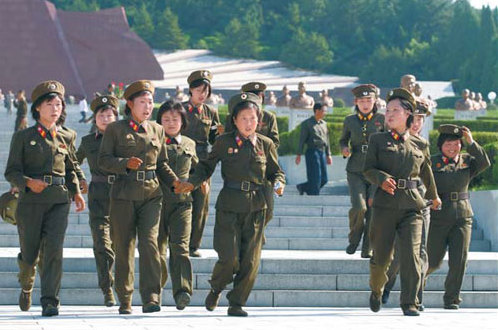DPRK unveiled through the lens
|
Female soldiers leave the Cemetery of Revolutionary Martyrs in Pyongyang after paying homage to the martyrs, on Sept 15, 2012. |
DPRK people's passion for arts convinced China Daily reporter Feng Yongbin that the young people will usher in a bright future for the country
The Democratic People's Republic of Korea, a mystery to the outside world, opened its multifarious aspects to me, my camera lens, to be precise, during my first visit to the country from Sept 12 to 17. My eyes were wide open searching for details that distinguish it from other countries, because I knew not many photographers get the opportunity to present the real DPRK through their photographs.
My first impression of the country was formed during the short trip from the airport to downtown Pyongyang. The almost empty and wide streets made a Beijinger like me feel lonely. Yet the huge squares with magnificent bronze statues of state leaders, manicured lawns, hurtling streetcars and shy and curious passers-by added to the charm of the DPRK capital.
Libraries, amusement parks, theatres, stadiums, universities, hotels and hospitals were orderly lined along the streets like honor guards. Although most of them were built years ago, their huge size, despite their somewhat dull appearance, complemented each other and highlighted the atmosphere of the city.
Everything was clean and well maintained. In fact, the visit reinforced my impression of Pyongyang's cleanliness.
Many people were engaged in cleaning flowerbeds in the streets. Some of them told me that the government attaches great importance to developing clean habits and a healthy lifestyle.
I was lucky to get a chance to watch the famous Arirang show, a group callisthenics adapted from a Korean folk song, which is performed by 100,000 people. Pyongyang may be the only place in the world where you can enjoy such a fantastic live show. Anywhere else, one can synchronize and choreograph such a show only in the virtual world.
Arirang is just one example of DPRK people's passion for arts and entertainment. Apart from watching on average 10 films a year, people love to go to a circus or acrobatics show.
The authorities provide all kinds of artistic training for children. The activity center for children in Pyongyang is spread over 300,000 square meters and has more than 200 rooms for children with different hobbies.
Paying attention to quality education, especially adolescent education, is a tradition in the DPRK. The government provides 11-year free compulsory education from the primary- to middle-school level. And students get all kinds of subsidies from the government to cover their living costs and school education.
The DPRK is one of the few countries in the world that has eliminated illiteracy totally, and its more than 300 colleges and universities cover almost all academic fields.
My visit to the DPRK convinced me that the young people will usher in a bright future for the country and that they need to let development come about naturally.
China Daily



















